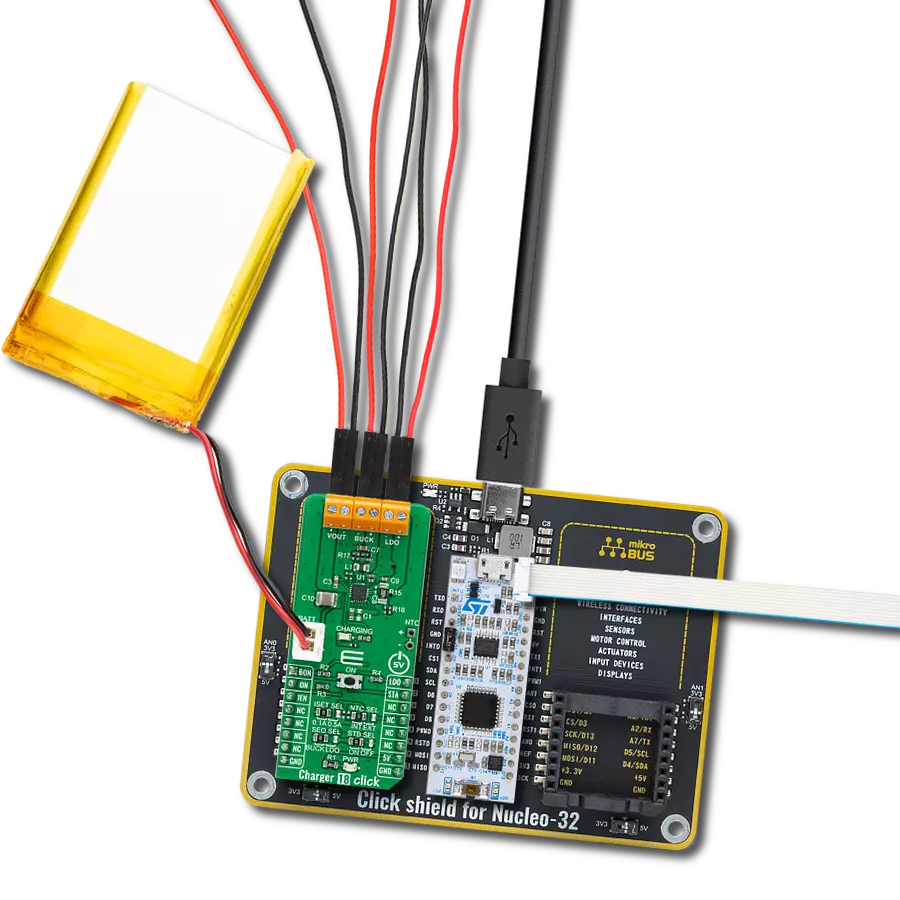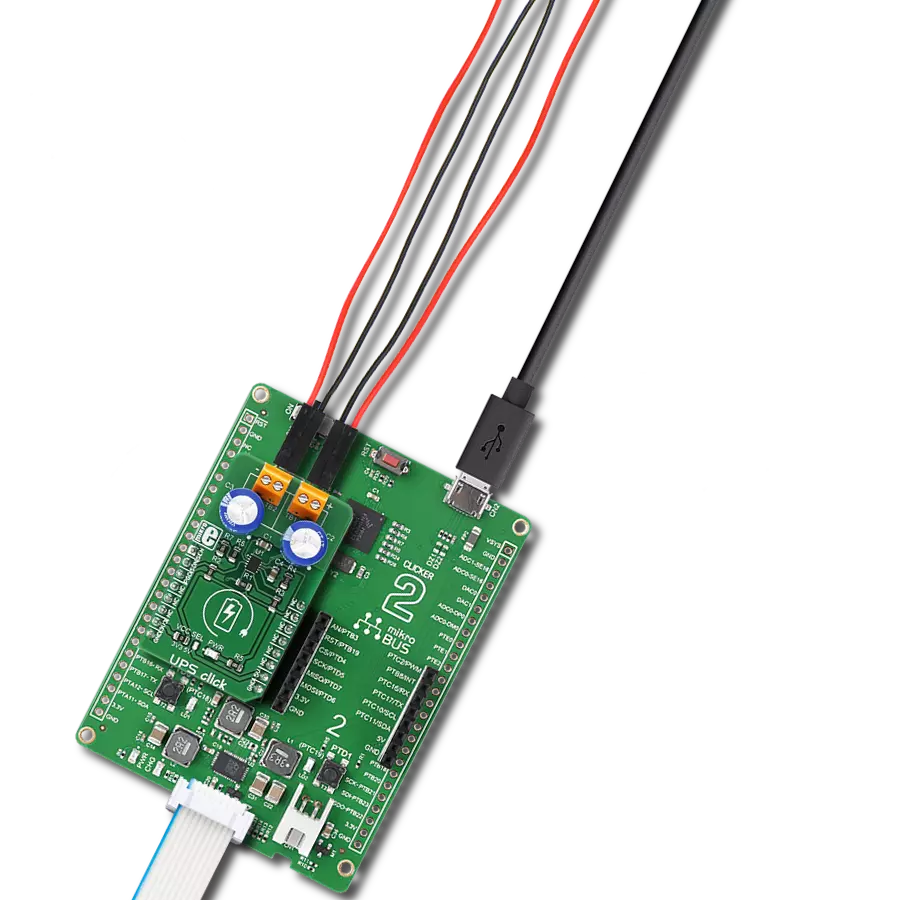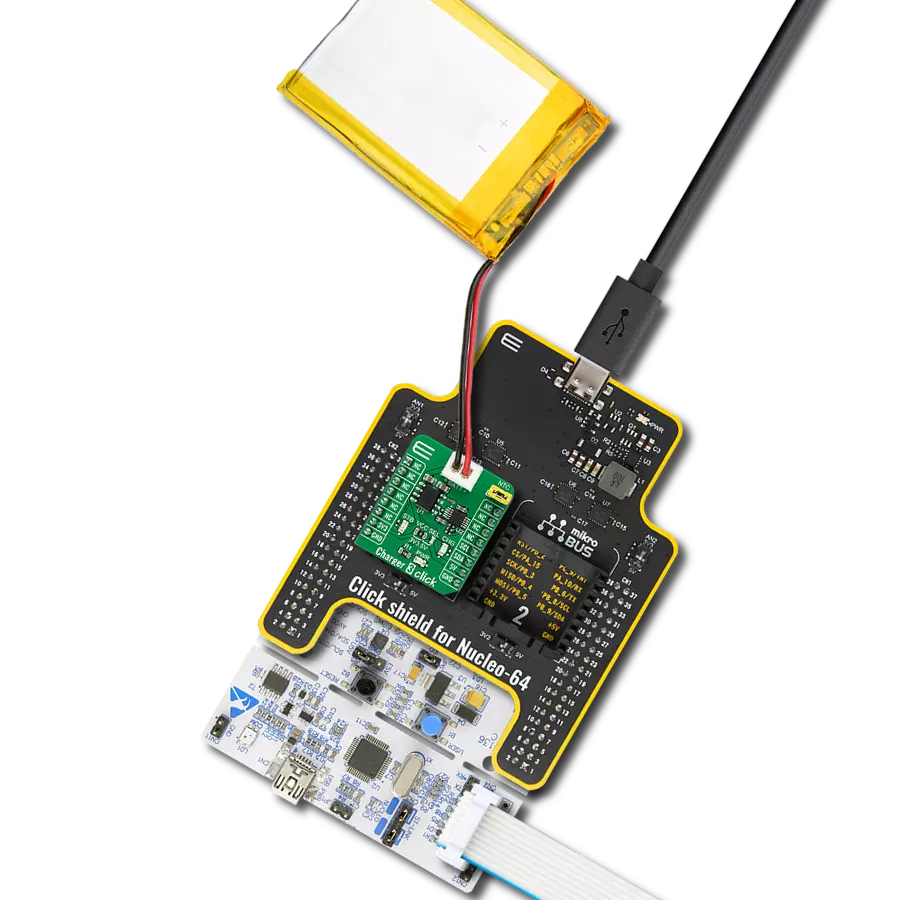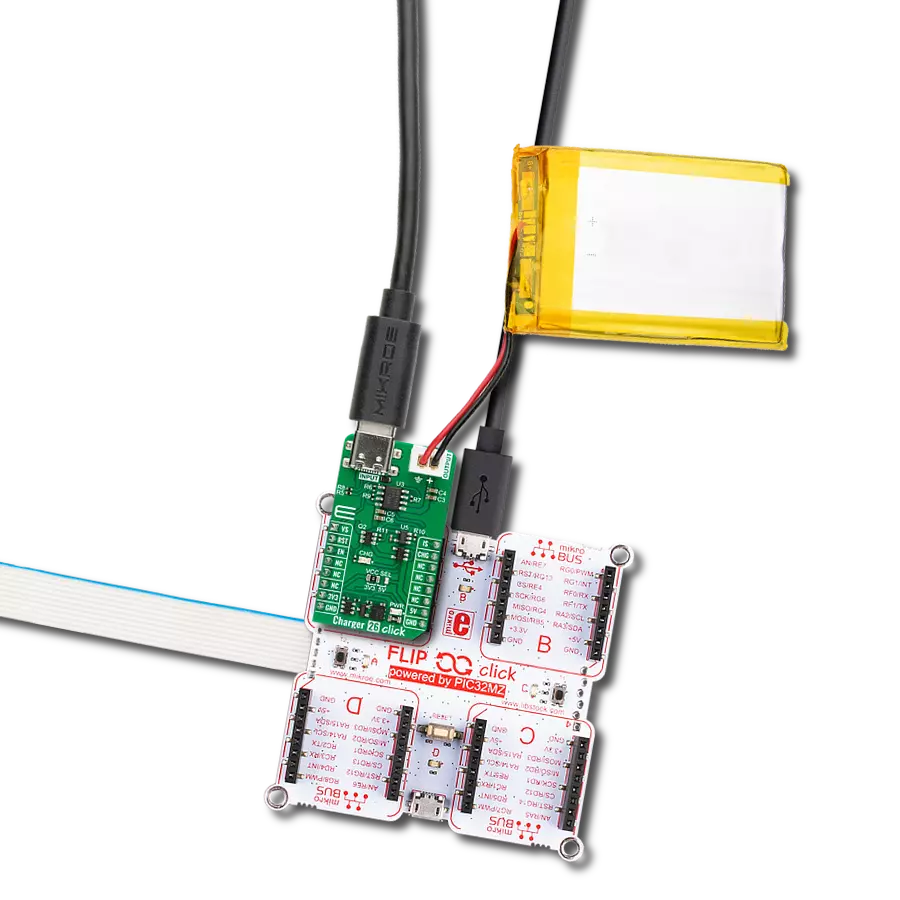Power up your portable devices with an advanced single-cell Li-Ion or Li-Polymer switching charger, designed for a wide input range and on-the-go applications
A
A
Hardware Overview
How does it work?
Charger 27 Click is based on the MP2639B, a Li-Ion or Li-Polymer switching charger from MPS. The charger works in three modes: charge, discharge, and sleep mode. It operates as a switching charger if the input power supply is available. The charger automatically detects the battery voltage and charges the battery in three phases: pre-charge, constant charge, and constant voltage charge. Other features include charge termination and auto-recharge. When the input is absent, the charger can provide a boost voltage to the VIN terminal, the same which is used for the input voltage power supply. This Click board™ uses a
general-purpose I/O to allow the host MCU to control the MP2639B charger. Besides the push button, you can also select charge mode by pulling the MD pin to a LOW logic state and discharge mode by pulling this pin to a HIGH logic state. The charger uses the CHG pin to indicate the host MCU of the charge status and the AOK pin to indicate the valid input supply. There are several LEDs on the Charger 27 Click. LEDs labeled 1 – 4 represent a fuel gauge. The charge completion indicator is available over the CHG LED, and the valid input supply indicator is available over the AOK LED. The discharge function is enabled by pressing the
onboard button for less than 2.5 seconds. If the discharge is enabled, you can turn off this feature by pressing the button longer than 2.5 seconds. You can also set the charge current between 1A and 2A over the ISET SEL jumper. This Click board™ can operate with either 3.3V or 5V logic voltage levels selected via the VCC SEL jumper. This way, both 3.3V and 5V capable MCUs can use the communication lines properly. Also, this Click board™ comes equipped with a library containing easy-to-use functions and an example code that can be used as a reference for further development.
Features overview
Development board
Arduino UNO is a versatile microcontroller board built around the ATmega328P chip. It offers extensive connectivity options for various projects, featuring 14 digital input/output pins, six of which are PWM-capable, along with six analog inputs. Its core components include a 16MHz ceramic resonator, a USB connection, a power jack, an
ICSP header, and a reset button, providing everything necessary to power and program the board. The Uno is ready to go, whether connected to a computer via USB or powered by an AC-to-DC adapter or battery. As the first USB Arduino board, it serves as the benchmark for the Arduino platform, with "Uno" symbolizing its status as the
first in a series. This name choice, meaning "one" in Italian, commemorates the launch of Arduino Software (IDE) 1.0. Initially introduced alongside version 1.0 of the Arduino Software (IDE), the Uno has since become the foundational model for subsequent Arduino releases, embodying the platform's evolution.
Microcontroller Overview
MCU Card / MCU

Architecture
AVR
MCU Memory (KB)
32
Silicon Vendor
Microchip
Pin count
28
RAM (Bytes)
2048
You complete me!
Accessories
Click Shield for Arduino UNO has two proprietary mikroBUS™ sockets, allowing all the Click board™ devices to be interfaced with the Arduino UNO board without effort. The Arduino Uno, a microcontroller board based on the ATmega328P, provides an affordable and flexible way for users to try out new concepts and build prototypes with the ATmega328P microcontroller from various combinations of performance, power consumption, and features. The Arduino Uno has 14 digital input/output pins (of which six can be used as PWM outputs), six analog inputs, a 16 MHz ceramic resonator (CSTCE16M0V53-R0), a USB connection, a power jack, an ICSP header, and reset button. Most of the ATmega328P microcontroller pins are brought to the IO pins on the left and right edge of the board, which are then connected to two existing mikroBUS™ sockets. This Click Shield also has several switches that perform functions such as selecting the logic levels of analog signals on mikroBUS™ sockets and selecting logic voltage levels of the mikroBUS™ sockets themselves. Besides, the user is offered the possibility of using any Click board™ with the help of existing bidirectional level-shifting voltage translators, regardless of whether the Click board™ operates at a 3.3V or 5V logic voltage level. Once you connect the Arduino UNO board with our Click Shield for Arduino UNO, you can access hundreds of Click boards™, working with 3.3V or 5V logic voltage levels.
Li-Polymer Battery is the ideal solution for devices that demand a dependable and long-lasting power supply while emphasizing mobility. Its compatibility with mikromedia boards ensures easy integration without additional modifications. With a voltage output of 3.7V, the battery meets the standard requirements of many electronic devices. Additionally, boasting a capacity of 2000mAh, it can store a substantial amount of energy, providing sustained power for extended periods. This feature minimizes the need for frequent recharging or replacement. Overall, the Li-Polymer Battery is a reliable and autonomous power source, ideally suited for devices requiring a stable and enduring energy solution. You can find a more extensive choice of Li-Polymer batteries in our offer.
Used MCU Pins
mikroBUS™ mapper
Take a closer look
Click board™ Schematic

Step by step
Project assembly
Software Support
Library Description
This library contains API for Charger 27 Click driver.
Key functions:
charger27_set_mode- This function is used for the charge or discharge mode selectioncharger27_check_chg_completion- This function checks the charging completion indicator statecharger27_check_input_supply- This function checks valid input supply indicator state
Open Source
Code example
The complete application code and a ready-to-use project are available through the NECTO Studio Package Manager for direct installation in the NECTO Studio. The application code can also be found on the MIKROE GitHub account.
/*!
* @file main.c
* @brief Charger 27 Click Example.
*
* # Description
* This example demonstrates the use of the Charger 27 Click board
* by enabling charge or discharge mode and
* indicating valid input supply and charging completion.
*
* The demo application is composed of two sections :
*
* ## Application Init
* Initialization of GPIO module and log UART.
* After driver initialization, the app sets charge mode.
*
* ## Application Task
* The Charger 27 Click board operates as a switching charger to charge a 1S battery
* from a wide input power range of 5V to 16V, which can cover a USB PD voltage level.
* The demo application checks and displays the charging completion indicator status.
* Results are being sent to the UART Terminal, where you can track their changes.
*
* @author Nenad Filipovic
*
*/
#include "board.h"
#include "log.h"
#include "charger27.h"
static charger27_t charger27; /**< Charger 27 Click driver object. */
static log_t logger; /**< Logger object. */
void application_init ( void )
{
log_cfg_t log_cfg; /**< Logger config object. */
charger27_cfg_t charger27_cfg; /**< Click config object. */
/**
* Logger initialization.
* Default baud rate: 115200
* Default log level: LOG_LEVEL_DEBUG
* @note If USB_UART_RX and USB_UART_TX
* are defined as HAL_PIN_NC, you will
* need to define them manually for log to work.
* See @b LOG_MAP_USB_UART macro definition for detailed explanation.
*/
LOG_MAP_USB_UART( log_cfg );
log_init( &logger, &log_cfg );
log_info( &logger, " Application Init " );
// Click initialization.
charger27_cfg_setup( &charger27_cfg );
CHARGER27_MAP_MIKROBUS( charger27_cfg, MIKROBUS_1 );
if ( DIGITAL_OUT_UNSUPPORTED_PIN == charger27_init( &charger27, &charger27_cfg ) )
{
log_error( &logger, " Communication init." );
for ( ; ; );
}
if ( CHARGER27_OK == charger27_set_mode( &charger27, CHARGER27_MODE_CHARGE ) )
{
log_printf( &logger, " > Charge mode <\r\n" );
Delay_ms ( 100 );
}
}
void application_task ( void )
{
if ( CHARGER27_CHG_CHARGE == charger27_check_chg_completion( &charger27 ) )
{
log_printf( &logger, " Charging.\r\n" );
Delay_ms ( 1000 );
}
else
{
log_printf( &logger, " Charging has completed or is suspended.\r\n" );
Delay_ms ( 1000 );
}
}
int main ( void )
{
/* Do not remove this line or clock might not be set correctly. */
#ifdef PREINIT_SUPPORTED
preinit();
#endif
application_init( );
for ( ; ; )
{
application_task( );
}
return 0;
}
// ------------------------------------------------------------------------ END
Additional Support
Resources
Category:Battery charger




































